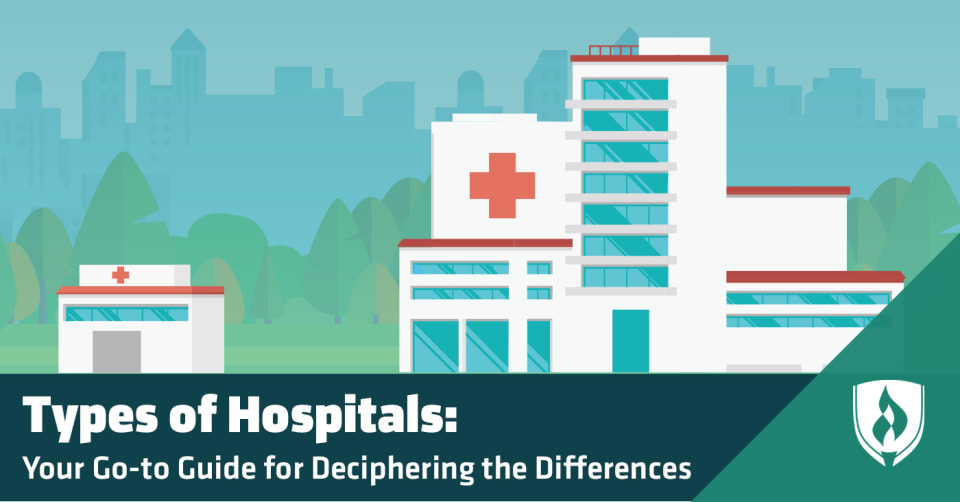Types of Hospitals: Your Go-to Guide for Deciphering the Differences
By Kirsten Slyter on 11/19/2018

It’s almost guaranteed that at some point in your life you will visit a hospital, whether as a patient for a surgery, for an ER visit, to get a test done or to visit a loved one. You might think they’re all basically the same, but with 5,534 registered hospitals in the U.S., there’s a surprising amount of variety in the types of hospitals out there.1
Hospitals are categorized in a variety of ways—by the type of care they give, their size, and their funding structure are some common examples. These categories aren’t mutually exclusive, though, and that can make things a little confusing—for example, you can find a small, private, rural, acute-care hospital
So what does it all mean? This guide will help you make sense of the common distinctions between types of hospitals and how they operate.
Types of hospitals by size
One of the most obvious categories for comparing types of hospitals is the size of the institution. Hospital size is categorized based on how many beds it contains. The definition of what makes a hospital small, medium or large can vary depending on who you ask, but generally the lines break down into groupings similar to this:
- Small hospitals contain fewer than 100 beds
- Medium hospitals contain between 100 to 499 beds
- Large hospitals contain at least 500 or more beds
Hospital size often corresponds to location. Rural hospitals tend to be much smaller, while larger hospitals generally only exist in urban areas. This shouldn’t come as a surprise—with a higher population density in urban areas, larger facilities are needed to accommodate the needs of the community.
Types of hospitals: Acute vs. Long-term care
Another potential distinction is whether a hospital specializes in long-term care. To be clear, the vast majority of all hospitals provide acute care. This means that they primarily care for patients dealing with illnesses, diseases, injuries, surgeries, surgery recoveries, obstetric care, postnatal care and trauma.
Long-term hospitals (LTCH) are often certified as acute-care hospitals, but also specialize in patients who on average, stay more than 25 days and are usually transferred from the ICU or a critical care unit, according to the Centers for Medicare and Medicaid Services.2 These patients often have more than one serious condition, and sometimes need to be treated with respiratory therapy, pain management treatments or for trauma to the head. Long-term patients often improve with time and care and are able to return home.
For-Profit vs. Not-For-Profit vs. Government-owned
Another potential differentiator between hospitals is the ownership structure. There are three primary options—For-profit, not-for-profit and publicly owned hospitals. Just over 51 percent of all registered hospitals are not-for-profit, according to the American Hospital Association.1 This means that they are not obligated to shareholders to earn profits—but that doesn’t mean they’re running a charity, either, as they need to remain financially viable. The biggest distinction is that excess funds typically remain in the hospital and can be invested in new technology, staff or research.
For-profit hospitals, on the other hand, are similar to other private businesses in that they are beholden to investors. Stakeholders demand a return on their investment, which can influence hospital operations. This means that there’s an increased pressure for for-profit hospitals to focus on efficiency in order lower costs. Some may concentrate on particularly profitable procedures and services in order to maximize profitability.
Publicly owned government hospitals are taxpayer-funded. In the U.S., these facilities are often associated with medical schools and do not have investors and quarterly profit projections to meet. That doesn’t mean budgets go out the window—there can still be challenges if public funding levels don’t keep up with patient demand and the needs of a facility.
Types of hospitals: Rural vs. urban
As mentioned in the size section, rural hospitals tend to be smaller and often fewer than 100 beds. Even more limited are “critical access” hospitals, containing fewer than 25 beds and are located 35 or more miles from the nearest hospital. These small hospitals depend heavily on Medicaid and Medicare funding to remain viable.
Urban hospitals are generally larger and have more competition as they are in densely populated areas with multiple hospitals for patients to choose from. Because of this competition, many urban hospitals specialize, either offering more versatility in treatment options and patient-experience perks.
Types of hospitals: Teaching vs. non-teaching
Teaching hospitals are affiliated with a university, medical schools or nursing schools. Interns, students and fellows work and learn at teaching hospitals while being supervised by qualified physicians, department leaders and other medical staff.
Non-teaching hospitals serve only the local community and don’t partner with any universities or medical schools. Does this make them better than teaching hospitals? Not necessarily. Teaching hospitals tend to treat sicker patients in order to provide more experiences to the students. Often these hospitals conduct academic medical research and have patients that take part in clinical trials designed to determine the effectiveness of new treatments. This can have a skewing effect on patient outcomes—many clinical trial participants seek out these less-proven treatments because their other options may be limited.
A teaching hospital may be a rewarding setting for experienced hospital staffers. Matthew Thomson RN, BSN, CCRN of The RN Mentor, has worked at two academic medical centers and says he loves the culture.
“What I enjoy the most about academic medical centers is the focus on learning,” Thomson says. “Attending physicians know that they are teaching the next generation of doctors. There’s a culture of mutual learning and respect.”
Types of hospitals: Federal hospitals vs. State and local hospitals
This classification of government-run public hospitals is based on where the funding comes from. Federal hospitals are run and funded by the federal government include mostly Veterans’ Administration hospitals and clinics. The Department of Defense and the Department of Health and Human Services also run federally funded hospitals, but these hospitals aren’t commonly found in most communities.
Some hospitals are operated and funded by local state or county governments. These hospitals rely primarily on funding from local governments—though federal money via grants, Medicare and Medicaid payments certainly is part of their budget. These facilities are highly dependent on local funding—so they’ve seen some strain in states facing tough financial times.
Types of hospitals: Independent vs. hospitals in a system
Many hospitals are a part of a system that can include one or multiple hospitals and several clinics and separate specialized facilities. This allows for more comprehensive outpatient care once a patient leaves the hospital or emergency room. Independent hospitals that are not a part of a system are becoming rare as mergers are becoming more common.
Independent hospitals and hospitals in a system can both be a part of a healthcare network— a group of healthcare facilities, physicians, insurers, agencies and others that work together to coordinate services. Though they have separate administration systems, they collaborate for the community’s benefit.
Types of hospitals: Trauma levels
In addition to being classified by funding and function, hospitals are also evaluated based on their readiness to treat trauma resulting from accidents, falls, gunshot wounds or other massive injuries. Though criteria for the trauma categories vary from state to state, there are common denominators. Let’s take a look at the polar ends of the trauma center scale to get a better idea of what these designations mean.
Level I trauma centers can provide total care, from prevention through rehab, for traumatic injuries. They provide 24-hour in-house coverage by general surgeons, and specialists like orthopedic surgeons, neurosurgeons, plastic surgeons, anesthesiologists and other critical-care providers. The hospital has to meet a minimum requirement of seriously injured patients in their care each year. In addition to providing top notch and prompt care, they also provide public education and leadership in prevention while being a referral resource for community members in the area, according to the American Trauma Society.5
On the other end of the trauma center spectrum, Level-V centers can provide initial evaluation, stabilization and diagnostic capabilities by one or more trauma nurses and physicians before transferring patients, if needed, to Levels I through III trauma centers that they have agreements with. Level-V centers may be able to provide surgery and critical-care services, but it is not guaranteed.
Types of hospitals: Specialty hospitals
Outside of these primary categorizations, there are many other types of hospitals, usually specializing in certain types of care. Here are three common examples of specialty hospitals:
- Children’s hospitals focus on conditions and diseases that affect young patients. The staff at these hospitals are specially trained to work with children and are able to offer psychosocial support for the children who require extended stays.
- Research hospitals are committed to discovering cures for certain conditions while treating various illness and diseases.
- Psychiatric hospitals specialize in mental health needs and illness using medication, psychotherapy and behavioral therapies. Some focus on short-term, emergent treatment, while some guide patients through long-term stabilization.
What about the people who work in hospitals?
The medical landscape is constantly changing, so these categorizations should be considered along with current changes in insurance and federal and private funding. Now that you know which hospital does what, you might be wondering about the people who make hospitals effective. If you’d like to learn more about the common healthcare careers you’ll find in a hospital setting, check out our infographic, “Who’s Who in a Hospital: Your Visual Guide to Medical Jobs.”
1American Hospital Association, Fast Facts on U.S. Hospitals, 2018 [information accessed October 17, 2018] https://www.aha.org/statistics/fast-facts-us-hospitals
2Centers for Medicare and Medicaid Services, What Are Long-Term Care Hospitals? [information accessed October 17, 2018] https://www.medicare.gov/Pubs/pdf/11347-Long-Term-Care-Hospitals.pdf
3American Trauma Society, Trauma Center Levels Explained [information accessed October 17, 2018] https://www.amtrauma.org/page/traumalevels




